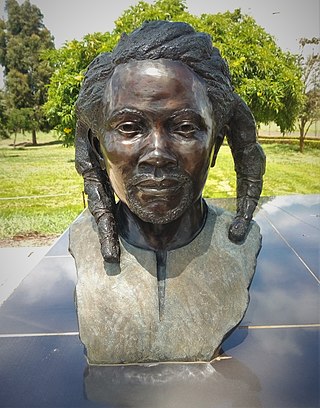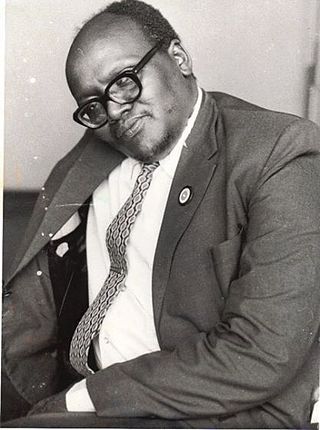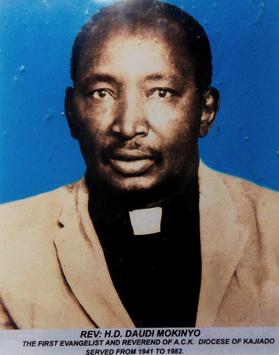Related Research Articles

A part of Eastern Africa, the territory of what is known as Kenya has seen human habitation since the beginning of the Lower Paleolithic. The Bantu expansion from a West African centre of dispersal reached the area by the 1st millennium AD. With the borders of the modern state at the crossroads of the Bantu, Nilo-Saharan and Afro-Asiatic ethno-linguistic areas of Africa, Kenya is a truly multi-ethnic state. The Wanga Kingdom was formally established in the late 17th century. The kingdom covered from the Jinja in Uganda to Naivasha in the East of Kenya. This is the first time the Wanga people and Luhya tribe were united and led by a centralized leader, a king, known as the Nabongo.

Daniel Toroitich arap Moi was a Kenyan politician who served as the second president of Kenya from 1978 to 2002. He is the country's longest-serving president to date. Moi previously served as the third vice president of Kenya from 1967 to 1978 under President Jomo Kenyatta, becoming the president following the latter's death.

The Kenya African National Union (KANU) is a Kenyan political party that ruled for nearly 40 years after Kenya's independence from British colonial rule in 1963 until its electoral loss in 2002. It was known as Kenya African Union (KAU) from 1944 but due to pressure from the colonial government, KAU changed its name to Kenya African Study Union (KASU) mainly because all political parties were banned in 1939 following the start of the Second World War. In 1946 KASU rebranded itself into KAU following the resignation of Harry Thuku as president due to internal differences between the moderates who wanted peaceful negotiations and the militants who wanted to use force, the latter forming the Aanake a forty, which later became the Mau Mau. His post was then occupied by James Gichuru, who stepped down for Jomo Kenyatta in 1947 as president of KAU. The KAU was banned by the colonial government from 1952 to 1960. It was re-established by James Gichuru in 1960 and renamed KANU on 14 May 1960 after a merger with Tom Mboya's Kenya Independence Movement.

The Kenya African Democratic Union (KADU) was a political party in Kenya. It was founded in 1960 when several leading politicians refused to join Jomo Kenyatta's Kenya African National Union (KANU). It was led by Ronald Ngala who was joined by Moi's Kalenjin Political Alliance, the Masai United Front, the Kenya African Peoples Party, the Coast African Political Union, Masinde Muliro's Baluhya Political Union and the Somali National Front. The separate tribal organisations were to retain their identity and so, from the very start, KADU based its political approach on tribalism. KADU's aim was to defend the interests of the so-called KAMATUSA as well as the British settlers, against the imagined future dominance of the larger Luo and Kikuyu that comprised the majority of KANU's membership, when it became inevitable that Kenya will achieve its independence. The KADU objective was to work towards a multiracial self government within the existing colonial political system. After release of Jomo Kenyatta, KADU was becoming increasingly popular with European settlers and, on the whole, repudiated Kenyatta's leadership. KADU's plan at Lancaster meetings was devised by European supporters, essentially to protect prevailing British settlers land rights.

Dedan Kimathi Waciuri in what was then British Kenya, was the senior military and spiritual leader of the Kikuyu rebels involved in the Mau Mau Uprising. Widely regarded as a revolutionary leader, he led the armed military struggle against the British colonial regime in Kenya in the 1950s until his capture in 1956 and execution in 1957. Kimathi is credited with leading efforts to create formal military structures within the Mau Mau, and convening a war council in 1953. He, along with Baimungi M'marete, Musa Mwariama, General China and Muthoni Kirima, was one of the Field Marshals.

The Luhya are a Bantu people and the second largest ethnic group in Kenya. The Luhya belong to the larger linguistic stock known as the Bantu. The Luhya are located in western Kenya and Uganda. They are divided into 20 culturally and linguistically united clans. Once known as the Kavirondo, multiple small tribes in North Nyanza came together under the new name Baluhya between 1950 and 1960. The Bukusu are the largest Luhya subtribe and account for almost 50% of the entire Luhya population, dominating other Luhya subtribes. They live in both Bungoma and Trans-Nzoia counties.

The Bukusu people are one of the 17 Kenyan tribes of the Luhya Bantu people of East Africa residing mainly in the counties of Bungoma and Trans Nzoia. They are the largest tribe of the Luhya nation, with 1,188,963 identifying as Bukusu in the 2019 Kenyan census. They speak the Bukusu dialect.

Thomas Joseph Odhiambo Mboya was a Kenyan trade unionist, educator, Pan-Africanist, author, independence activist, and statesman. He was one of the founding fathers of the Republic of Kenya. He led the negotiations for independence at the Lancaster House Conferences and was instrumental in the formation of Kenya's independence party – the Kenya African National Union (KANU) – where he served as its first Secretary-General. He laid the foundation for Kenya's capitalist and mixed economy policies at the height of the Cold War and set up several of the country's key labour institutions.
Henry Pius Masinde Muliro was a Kenyan politician from the Bukusu sub-tribe of the larger Abaluhya people of western Kenya. He was one of the central figures in the shaping of the political landscape in Kenya. An anti-colonial activist, he campaigned for the restoration of multi-party democracy in Kenya in his later years.

Michael Christopher Kijana Wamalwa was a renowned Kenyan politician who at the time of his death was serving as the eighth Vice-President of Kenya.

Bethwell Allan Ogot is a Kenyan historian and eminent African scholar who specialises in African history, research methods and theory. One of his works starts by saying that "to tell the story of a past so as to portray an inevitable destiny is, for humankind, a need as universal as tool-making. To that extent, we may say that a human being is, by nature, historicus.
Josephat Njuguna Karanja was the fifth Vice-President of the Republic of Kenya between 1988 and 1989.

Jean-Marie Seroney was a Kenyan human rights advocate, a legislator, and an Amnesty International prisoner of conscience. He was detained as a prisoner of conscience for 1,155 days.
Kirya Balaki Kebba the ex-rebel leader now-defunct rebel Uganda Freedom Movement who was kidnapped by security agents from Jamuhuri estate in Nairobi while in exile in the Republic of Kenya and brought back to Uganda. Kirya Balaki Kebba was acquitted of Treason charges in 1983 but was detained.

Eric Edward Khasakhala, known as "Omwana wa Kwendo" was a Kenyan politician, educationist, Pan Africanist, independence activist, Cabinet Minister and one of the founding fathers of the Republic of Kenya. He was a participant of the delegation at the negotiations for Independence at the Lancaster House Conferences; he was instrumental in the formation of Kenya's Kenya African Democratic Union (KADU) party, which he served as one of the party officers. The KADU advocated for the federalist post independent Kenya.
John Keen was a Kenyan politician. He served as an assistant minister for agriculture and member of parliament (MP) for Kajiado North Constituency from 1969 to 1979. In 1991 together with Mwai Kibaki, he founded the Democratic Party, for which he served as secretary general. He carved a reputation as a defender of the Maasai community's land rights.
The Mwakenya Movement was an underground socialist movement in Kenya in the 1980s formed to fight for multi-party democracy.

Haron Daudi Mokinyo ole Loolpisia is the first Maasai clergyman of the Anglican Church of Kenya, ordained in 1951 in All Saints Cathedral Nairobi. He was also the first Maasai to own a ranch during the colonial period in 1950. He owned a 4000-acre ranch called Oloisur which was located near Toroka station on the Magadi branch railway. His ranch was home to over 200 exotic breeds of cows.
Barsirian Arap Manyei was the last widely recognized Nandi Orkoiyot and Kenya's longest serving political detainee.

The presidency of Daniel arap Moi began on 22 August 1978, when Daniel arap Moi was sworn in as the 2nd President of Kenya, and ended on 30 December 2002. Moi, a KANU party member, took office following the death of the then president Jomo Kenyatta on the same day. He was sworn as interim president for 90 days during which the country was to prepare for a presidential election to be held on 8 November. Moi won reelections in 1988, 1992 and 1997, defeating Mwai Kibaki in the latter two elections. He was succeeded by Mwai Kibaki in 2002. He died at the age of 95 on 4 February 2020
References
- ↑ Daily Nation, 29 June 2008: SOCCER: When Elijah Masinde sneaked from team camp Archived 29 June 2008 at the Wayback Machine
- ↑ Daily Nation, 12 November 2007: Masinde family supports Raila [ permanent dead link ]
- Makila, F. E. (1978) An Outline History of Babukusu of Western Kenya. Nairobi, Kenya: Kenya Literature Bureau.
- Alembi, Ezekiel. (2000) Elijah Masinde: Rebel with a cause. Nairobi, Kenya: Sasa Sema Publications Ltd.